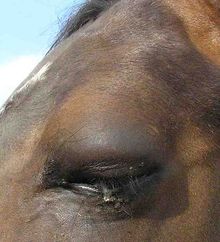Eyelid injuries and eye irritation in horses sometimes occur and can be very serious if neglected. The fall season often produces plant burrs and dry leaves that may stick to horse eyelids and cause irritation if not noticed and removed immediately.

A painful horse's eye
Eye problems often occur in the fall when horses get tiny bristles from burdock burrs caught in the eye which are hard to see and generally create a chronic eye irritation.
© 2012 by Montanabw
In addition, bucket and tack hooks along with other fixtures in the stable, barn or paddock can tear or snag a horse's eyelid causing discomfort and the possibility of serious infection that may affect the eye.
According to Ann Dwyer DVM, a private practitioner at the Genesee Valley Equine Clinic, in Scottsville, New York, the most common problems she sees that do not involve the globe of the eye are eyelid tears. The snag or tear should be repaired as soon as possible, and can sometimes be put back together even if they look horrendous.
Dr. Dwyer cautions, “Never trim or cut off a dangling piece, even if it’s hanging by just a thread of tissue. These can sometimes be repaired, and the sooner the better. Even if it looks like there’s no way it could be put back together, often we can repair the injury,” says Dwyer.
“I am often presented with horses who have old eyelid defects; someone made a mistake long ago and either didn’t try to fix the injury or fixed it poorly, and the horse has chronic pain because the eyelashes turn in and rub on the cornea or the lid can’t close properly over the globe.
Sometimes a repair is very difficult but, in other cases, it’s fairly simple. It’s frustrating to me if the owner won’t go the extra mile to fix it, because the horse is in chronic discomfort,” she says.
Foreign matter such as plant material can sometimes get caught in or under an eyelid. If something gets stuck under the eyelid, it may scrape and irritate the surface of the cornea each time the horse blinks. “We often see eye problems in the fall when horses get tiny bristles from burdock burrs caught in the eye. These are hard to see and generally create a chronic eye irritation,” she says. The burrs are like Velcro™ and stick to horses’ manes, tails, and fetlock hair. When burrs are stuck to the horse and the horse rubs them or the burr-laden mane bumps against the horse’s face tiny burr bristles may get into the eye.
“The fragments may get stuck in the conjunctiva or the cornea itself, but the most common place we find them are in the inner corner of the eye, between the cornea and third eyelid, on the inside of the third eyelid,” she explains. This may scratch the eyeball each time the third eyelid moves over it.
Our advice to clients in our practice is to call us immediately if a horse suffers an eye injury. If they call us about a horse with a swollen, sore eye, we will see it that day. It isn’t an emergency where you drop everything and go within the next five minutes, but as far as I’m concerned it is a sameday emergency.”
